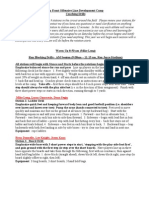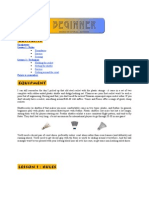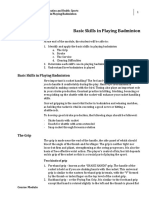Badminton 1º Eso
Badminton 1º Eso
Uploaded by
MiguelCopyright:
Available Formats
Badminton 1º Eso
Badminton 1º Eso
Uploaded by
MiguelOriginal Title
Copyright
Available Formats
Share this document
Did you find this document useful?
Is this content inappropriate?
Copyright:
Available Formats
Badminton 1º Eso
Badminton 1º Eso
Uploaded by
MiguelCopyright:
Available Formats
Bilingual Section – Physical Education – 2nd ESO
BASIC VOCABULARY AND RULES
Badminton is the fastest racket sport. The shuttle reaches 260 km/h!
Badminton is one of the most played sports in the World. It is a very popular sport in Asia and some parts
of Europe like Denmark and U.K. It is played with a shuttlecock on a rectangular court where players hit a
badminton bird back and forth over a net.
Like Tennis, it is played in Individual competitions (singles) or Doubles (with one person on each side, or
two).
Men and women can play together, as there are Mixed Doubles (a man and a woman).
Basic Vocabulary:
A match: un partido A game: un juego
Shuttle: volante Court: cancha
To rally: pelotear A Rally: la duración de un punto
Forehand: envés de la mano. En bádminton se usa para el golpe “de derechas”
Backhand: de revés Even: pares
Bounds: límites Odd: impares
Smash: remate Deception: engaño
Outright: directamente To deceive: engañar
To pretend: fingir, hacer como si... To follow through: seguir el movimiento
Below: por debajo To shake hands: darse la mano
How to play badminton
Badminton features one player opposing another, or competing pairs. The game is played on a surface
called a court. The object is to hit the shuttlecock past the opponent so it lands on the court, or to get the
opposition to make a mistake and hit the shuttlecock into the net or outside the court. You score a point
when your opponent can´t return the shuttle or the shuttle he/she returns falls out bounds.
How to win
Badminton games have a 21 points rally format, which means you don´t have to be serving to score a
point. There is no "service over", you can score a point no matter who serves.
1 Margarita Simón & Juan Riveiro – IES “Salvador de Madariaga” (A Coruña)
Bilingual Section – Physical Education – 2nd ESO
So, how do you play?
-To win a match, you have to win 2 out of 3 games. In a badminton match players aim to win the best of
three games.
-To win a game, you have to score 21 points.
-In singles, you serve on the right service court when your score is an even number and you serve on the
left service court when your score is an odd number.
-If a score becomes 20-20, the side which scores 2 consecutive points will win that game.
-If the score becomes 29-29, the side that scores the 30th point will win that game (30-29 is an acceptable
score for victory)..
The court and The serve
A badminton court is rectangular, with clearly marked white or yellow lines dividing it into different
sections. These different lines show where a long service and short service should be taken, and there are
also side lines and a centre line from one end of the court to the other.
The full width of the court is 6.1 metres, and in singles this width is reduced to 5.18 metres. The full length
of the court is 13.4 metres. The net is 1.55 metres high at the edges and 1.524 metres high in the centre.
2 Margarita Simón & Juan Riveiro – IES “Salvador de Madariaga” (A Coruña)
Bilingual Section – Physical Education – 2nd ESO
Light green and grey areas are the left and right service areas & singles – doubles service areas.
You serve from there and the shuttle must fall in the equivalent areas in your opponent´s court. If it falls
out of these areas, it is a fault.
After the service, all the areas are valid. The court for:
- Singles: 13.40 x 5,18 m. - Doubles: 13.40 x 6,10 m.
3 Margarita Simón & Juan Riveiro – IES “Salvador de Madariaga” (A Coruña)
Bilingual Section – Physical Education – 2nd ESO
The technique of the service (serve) :
When you hit the shuttle, the head of the racket must be completely below your waist. If you hit it with the
racket above the hip, it is a fault and you lose the point.
Relax your body and bend your knees slightly.
Place your non-racket leg on the front of your body. Bring your racket back and then swing it forwards.
Hold the shuttle by the feathers and let it drop slightly in front of you.
Hit it with the racket and follow through.
The tactic of the service (serve) :
This is the most important shot of your game. With a strong serve, you can win points and keep control of
the game. Vary between short and long serves to keep your opponent on his toes. Keeps the shuttlecock
low and close to the net for a short serve, forcing the opposition to move close to the net for the return.
4 Margarita Simón & Juan Riveiro – IES “Salvador de Madariaga” (A Coruña)
Bilingual Section – Physical Education – 2nd ESO
The grip
Key: “Shake hands and pull the trigger”
Forehand Grip
Use this grip to hit shuttles that are on the forehand
side of your body and around your head.
Place your hand on the handle as if you are shaking
hands with it.
There must be a V shape in between your thumb and
your index finger.
Backhand Grip:
Use this grip to hit shots that are on the backhand
side of your body.
Hold the racket as in the forehand grip.
Turn the racket to one side and place your thumb
against the back part of the handle for greater control
and power.
You need to learn to change grips quickly between
shots.
5 Margarita Simón & Juan Riveiro – IES “Salvador de Madariaga” (A Coruña)
Bilingual Section – Physical Education – 2nd ESO
The equipment
6 Margarita Simón & Juan Riveiro – IES “Salvador de Madariaga” (A Coruña)
Bilingual Section – Physical Education – 2nd ESO
Basic Skills
Basic position:
To react quickly you must have a good basic or waiting position.
Feet apart, more or less at the width of your shoulders. Bend your knees slightly. Hold the racket in front of
your body, head up. Weight on your toes. Move fast and hit the shuttle comfortably, apart from your body
with an ample movement.
The Clear: Overhead Shot (Key: “Overhead racket extension at contact”)
You can do forehand and backhand clears too.
You must hit the shuttle when it is over your head.
The clear makes the shuttle fly high and land on the back part of your opponent´s court. Use it to move
your opponent to the back of the court or to defend.
This is a very useful shot to regain positional control. Keep your elbow high and hit the shuttlecock when it
is still rising towards you in the air, and strike it hard towards the back of your opposition’s court space.
This takes some practice, to ensure you do not overshoot and hit the shuttlecock out, clearing the back line.
7 Margarita Simón & Juan Riveiro – IES “Salvador de Madariaga” (A Coruña)
Bilingual Section – Physical Education – 2nd ESO
The smash: Overhead Shot (Key: “Overhead racket extension at contact”)
It is the strongest of all badminton shots. There are forehand and backhand smashes.
To do a good smash, hit the shuttle further in front of your body than the clear.
The angle of the shuttle's trajectory makes it difficult for your opponent to return.
This shot can be almost unreturnable when executed accurately and with sufficient force. The smash is
used to end the point, and to assert your control over the game. Hit the shuttlecock hard and fast, when it is
approaching you high in the air.
The Drop: Overhead Shot (Key: “Overhead racket extension at contact”)
Badminton drop shots are delicate badminton shots that can win you points outright if executed well with
deception.
There are forehand and backhand drops.
Drop shots are usually disguised to make the opponent expect a smash or clear; you can use it pretending
to execute a smash,or a clear so your opponent moves to the back of the court A good drop shot can be
very deceptive, and can cause the opponent to reach the shuttle late and play a poor lift (giving an
opportunity to attack).
Slow your arm at the last minute and hit the shuttle slowly, so your opponent does not have time to run
to the front of the court.
Drop shots are played from your rearcourt. You hit the shuttle softly downwards to land in your opponent’s
forecourt area.
8 Margarita Simón & Juan Riveiro – IES “Salvador de Madariaga” (A Coruña)
Bilingual Section – Physical Education – 2nd ESO
The Lift or Lob: Underhand Shot (Key: “Hit out in front”)
Lifts are a badminton shot played from the midcourt or net area. A lift involves hitting the shuttle upwards
towards the back of your opponent’s court.
Lifts and clears are different shots:
- Lifts are played from the midcourt or net; clears are played from the rearcourt.
- Lifts use an underarm hitting action; clears use an overhead/overarm hitting action.
The terminology is often used inconsistently. Sometimes you will hear people call lifts "underarm clears",
in an attempt to avoid confusion.
The Net Shots: Underhand Shot (Key: “Lunge to the net, like a fencer”)
Net shots are delicate and sensitive. You don’t need any power, but you do need exquisite "touch" — the
ability to control the shuttle precisely.
Your fingertips are the most sensitive part of your hand. For net shots, therefore, you should hold the racket
in your fingertips, with a larger gap in your palm than for other shots.
Your racket should be well in front of you. You should be at full relaxed reach: you’re reaching forwards,
but there’s still a slight bend at your elbow. The racket frame should be oriented horizontally. Imagine you
are going to post the racket into a letterbox!
9 Margarita Simón & Juan Riveiro – IES “Salvador de Madariaga” (A Coruña)
Bilingual Section – Physical Education – 2nd ESO
Some Basic Rules
It shall be a ‘fault’:
1) If a service is not correct
2) If, in service, the shuttle:
2-1) is caught on the net and remains suspended on its top;
2-2) after passing over the net, is caught in the net; or
2-3) is hit by the receiver’s partner;
3) If in play, the shuttle:
3-1) lands outside the boundaries of the court (i. e. not on or within the boundary lines);
3-2) passes through or under the net;
3-3) fails to pass over the net;
3-4 touches the ceiling or side walls;
3-5) touches the person or dress of a player;
3-6) touches any other object or person outside the court;
3-7) is caught and held on the racket and then slung during the execution of a stroke;
3-8) is hit twice in succession by the same player. However, a shuttle hitting the head and the stringed area
of the racket in one stroke shall not be a ‘fault’;
3-9) is hit by a player and the player’s partner successively; or
3-10) touches a player’s racket and does not travel towards the opponent’s court
4) If, in play, a player:
4-1) touches the net or its supports with racket, person or dress;
4-2) invades an opponent’s court over the net with racket or person except that the striker may follow the
shuttle over the net with the racket in the course of a stroke after the initial point of contact with the shuttle
is on the striker’s side of the net;
10 Margarita Simón & Juan Riveiro – IES “Salvador de Madariaga” (A Coruña)
Bilingual Section – Physical Education – 2nd ESO
4-3) invades an opponent’s court under the net with racket or person such that an opponent is obstructed
or distracted; or
4-4) obstructs an opponent, i.e. prevents an opponent from making a legal stroke where the shuttle is
followed over the net;
4-5) deliberately distracts an opponent by any action such as shouting or making gestures;
11 Margarita Simón & Juan Riveiro – IES “Salvador de Madariaga” (A Coruña)
Bilingual Section – Physical Education – 2nd ESO
12 Margarita Simón & Juan Riveiro – IES “Salvador de Madariaga” (A Coruña)
You might also like
- Scale of Differentiation Updated 2012-02-13Document1 pageScale of Differentiation Updated 2012-02-13Maria Chiperi100% (1)
- Table Tennis: (First Semester 2020-2021)Document10 pagesTable Tennis: (First Semester 2020-2021)Ryan MarandaNo ratings yet
- Modern Arnis Training SystemsDocument19 pagesModern Arnis Training Systemswhatever111111No ratings yet
- Ict Action Plan 2019-2022Document2 pagesIct Action Plan 2019-2022Erika Jane Orejol Ulila88% (8)
- FMCG Industry (Snakes Company) Project - 177580002 PDFDocument108 pagesFMCG Industry (Snakes Company) Project - 177580002 PDFsatyam pandhare33% (3)
- GST Impact On Distribution NetworkDocument17 pagesGST Impact On Distribution NetworkrahulNo ratings yet
- Assignment #4 - Gardigo, Ray Iverson D.Document5 pagesAssignment #4 - Gardigo, Ray Iverson D.ray gardigoNo ratings yet
- Badminton Session 2Document5 pagesBadminton Session 2api-443327549No ratings yet
- Module 3 Individual and Dual Games SportsDocument10 pagesModule 3 Individual and Dual Games Sportsjoniel ajeroNo ratings yet
- Pe Module 2Document49 pagesPe Module 2Aimee Joy L HermosoraNo ratings yet
- History in BadmintonDocument28 pagesHistory in Badmintonbaruruth sapu-anNo ratings yet
- Basic Skills of BadmintonDocument5 pagesBasic Skills of BadmintonGIRLIE M. JABONITENo ratings yet
- Group 1 Written Report BADMINTONDocument10 pagesGroup 1 Written Report BADMINTONbrenda092797No ratings yet
- Basic Skills of Badminton: (1 and 30 Minutes Discussion 30 Minutes Assessment)Document5 pagesBasic Skills of Badminton: (1 and 30 Minutes Discussion 30 Minutes Assessment)Mixx MineNo ratings yet
- ARNISDocument12 pagesARNISPearl Kerby AbandoNo ratings yet
- BadmintonDocument13 pagesBadmintonjsbsubramanyamNo ratings yet
- Modern Arnis Training Systems (MATS) 1Document19 pagesModern Arnis Training Systems (MATS) 1Ismael TumaruNo ratings yet
- Badminton LessonDocument15 pagesBadminton LessonSamantha AceraNo ratings yet
- Lesson 3 ArnisDocument10 pagesLesson 3 ArnisEricaJane RamosNo ratings yet
- Camp Coaching Drills 2009Document7 pagesCamp Coaching Drills 2009vandelay_356564No ratings yet
- Jake Skill CardDocument1 pageJake Skill Cardapi-357001468No ratings yet
- BADMINTONDocument13 pagesBADMINTONCTSI- Cooling Tower System, Inc.No ratings yet
- Badminton SkillsDocument19 pagesBadminton SkillsDyriane PagsolinganNo ratings yet
- 11-Hope-2 Q3 Week10 Module10-2Document17 pages11-Hope-2 Q3 Week10 Module10-2Christian Jay BaldicanasNo ratings yet
- Beginner Badminton TutorialDocument19 pagesBeginner Badminton Tutorialgospod.jest1786No ratings yet
- Run & Hurdle Technique Technique & Drills SpottingDocument3 pagesRun & Hurdle Technique Technique & Drills Spottingcacamerba90No ratings yet
- Badminton SlideDocument37 pagesBadminton SlideRowena Villamor100% (1)
- 2019-20 CC Elementary Guide 27 PagesDocument27 pages2019-20 CC Elementary Guide 27 Pagesapi-340225800No ratings yet
- BadmintonDocument43 pagesBadmintonJezza Mae CalopezNo ratings yet
- Basic Knowledge and SkillsDocument3 pagesBasic Knowledge and SkillsBinzenNo ratings yet
- W2-Module Basic Skills in Playing BadmintonDocument4 pagesW2-Module Basic Skills in Playing BadmintonOtaku OverlordNo ratings yet
- Tema Voleibol 3º y 4º ESO. InglesDocument7 pagesTema Voleibol 3º y 4º ESO. InglesNicolás Muñoz GarcíaNo ratings yet
- Elementary Basketball Unit Plan David MichelDocument10 pagesElementary Basketball Unit Plan David Michelapi-501587142No ratings yet
- BadmintonDocument31 pagesBadmintonMiggymark Padillo NazarethNo ratings yet
- Officiating BadmintonDocument18 pagesOfficiating BadmintonMyleneNo ratings yet
- Reviewer in Badminton 2022Document11 pagesReviewer in Badminton 2022Annalyn Endaya AbelNo ratings yet
- Bartitsu Study Group - ExercisesDocument5 pagesBartitsu Study Group - Exercisesrubensxxx467% (3)
- Physical Ed. 2 Module 2Document12 pagesPhysical Ed. 2 Module 2Cherry Rose PaderesNo ratings yet
- Badminton Handout eDocument10 pagesBadminton Handout eapi-234854471No ratings yet
- Phys Ed - Badminton SMIDocument20 pagesPhys Ed - Badminton SMIAnikNo ratings yet
- Badminton Notes PDFDocument11 pagesBadminton Notes PDFAnonymous 5OdZI7R67% (3)
- Badminton Drop Shot SkillDocument6 pagesBadminton Drop Shot SkillChristine RidosNo ratings yet
- Module 104 SportsDocument11 pagesModule 104 SportsLeonso Visto JrNo ratings yet
- Basic Skills in Playing BadmintonDocument7 pagesBasic Skills in Playing BadmintonAerl XuanNo ratings yet
- Badminton - Ppt. Pe 3Document47 pagesBadminton - Ppt. Pe 3Lany IcamenNo ratings yet
- Modern Arnis Essentials Semi Final HandoutDocument10 pagesModern Arnis Essentials Semi Final HandoutALLIAH CARRIE FERRERNo ratings yet
- Pathfit 3 Lesson 5Document7 pagesPathfit 3 Lesson 5Rainiel MontalbaNo ratings yet
- Arnis PresentationDocument28 pagesArnis PresentationRucill NegadoNo ratings yet
- Individual and Dual Sports Midterm ModuleDocument14 pagesIndividual and Dual Sports Midterm ModuleLoraine Isabelle Guzman BarrogaNo ratings yet
- Home Learning TaskDocument3 pagesHome Learning TaskDaniela RochaNo ratings yet
- Basic Skills in ArnisDocument9 pagesBasic Skills in ArnisEzekiel John Surita Bada100% (1)
- Badminton: Done By: Ronel Panchoo Class:3C Physical EducationDocument11 pagesBadminton: Done By: Ronel Panchoo Class:3C Physical EducationRonel PanchooNo ratings yet
- HOPE-2 Q3 Mod10Document17 pagesHOPE-2 Q3 Mod10Mary Claire ObelloNo ratings yet
- PE2 Module 4 The Basic Skills of Badminton 1Document25 pagesPE2 Module 4 The Basic Skills of Badminton 1yearyveneil02No ratings yet
- Unit Plan Volleyball Year 7Document6 pagesUnit Plan Volleyball Year 7api-268822337No ratings yet
- Module 2B Pathfit 3 ServiceDocument3 pagesModule 2B Pathfit 3 ServiceJerah Marie PepitoNo ratings yet
- Individual /dual Sports and Games (PE3) : Wesleyan University - PhilippinesDocument6 pagesIndividual /dual Sports and Games (PE3) : Wesleyan University - Philippinesreyeselis0823No ratings yet
- Basic/ Fundamental Skills and Drills in Badminton (Written Report)Document4 pagesBasic/ Fundamental Skills and Drills in Badminton (Written Report)erickson hernan100% (1)
- Tolentino, John Carlo C. - BSMA-2A - Assignment2Document4 pagesTolentino, John Carlo C. - BSMA-2A - Assignment2john carlo tolentinoNo ratings yet
- PEH Week 5 Lesson 9Document27 pagesPEH Week 5 Lesson 9Akijumi OngNo ratings yet
- Shot and Discus 1Document2 pagesShot and Discus 1api-373706960No ratings yet
- Shot and Discus 1Document2 pagesShot and Discus 1api-443536947No ratings yet
- Shot and Discus 1Document2 pagesShot and Discus 1api-431813813No ratings yet
- OrganismDocument6 pagesOrganismLeonel OcanaNo ratings yet
- Experimental Studies On Utilization of Murrum As Hard Shoulder MaterialDocument6 pagesExperimental Studies On Utilization of Murrum As Hard Shoulder MaterialMercyano FebriandaNo ratings yet
- A Look at Moral Law: Christian Morality: Our Response To God's LoveDocument2 pagesA Look at Moral Law: Christian Morality: Our Response To God's Lovepat patNo ratings yet
- Illustrative Examples - Notes and Loans ReceivableDocument4 pagesIllustrative Examples - Notes and Loans ReceivableMelrose Eugenio ErasgaNo ratings yet
- Coal Handling PLantDocument8 pagesCoal Handling PLantPrasanna kumar subudhi100% (1)
- Final Exam Supervision of Instruction Jeannitte OnanDocument6 pagesFinal Exam Supervision of Instruction Jeannitte OnanJeannitte Gelos OnanNo ratings yet
- An Ontology For Sustainability ReportingDocument546 pagesAn Ontology For Sustainability ReportingOrsolya HeidenwolfNo ratings yet
- Micros 3700 Manager Procedures Reference GuideDocument28 pagesMicros 3700 Manager Procedures Reference GuideRafael CanulNo ratings yet
- Student Nurses' Community: Nursing Care Plan Assessment Diagnosis Inference Planning Intervention Rationale EvaluationDocument2 pagesStudent Nurses' Community: Nursing Care Plan Assessment Diagnosis Inference Planning Intervention Rationale EvaluationVen Belista86% (14)
- Udes Valentina Rueda Cambio de Valvula 1Document7 pagesUdes Valentina Rueda Cambio de Valvula 1api-756520112No ratings yet
- Chapter One 1.1. Background of The StudyDocument5 pagesChapter One 1.1. Background of The StudyZebene GecheNo ratings yet
- Cisco Uc500 Q ADocument10 pagesCisco Uc500 Q AElkarma MohamedNo ratings yet
- B9 - High Power Contactors (Ref) enDocument44 pagesB9 - High Power Contactors (Ref) enPablo Andres Jara GonzalezNo ratings yet
- Koha On Debian - Koha WikiDocument9 pagesKoha On Debian - Koha WikiPaolo BNo ratings yet
- India's Healthcare System: - Overview and Quality ImprovementsDocument48 pagesIndia's Healthcare System: - Overview and Quality ImprovementsJeevan DasmsNo ratings yet
- VALLEE de MAI Tower Inspection ReportDocument9 pagesVALLEE de MAI Tower Inspection ReportNuwan AnuradhaNo ratings yet
- SHAKER Academy 2020 - ABB Training PlanDocument6 pagesSHAKER Academy 2020 - ABB Training PlanHossam MagedNo ratings yet
- KWL Chart Handout V.finalDocument5 pagesKWL Chart Handout V.finalRodelita VillalobosNo ratings yet
- Konica FS-1Document17 pagesKonica FS-1Patrick StivénNo ratings yet
- In The High Court of Karnataka at Bengaluru: BetweenDocument15 pagesIn The High Court of Karnataka at Bengaluru: BetweenBIRENDER SINGHNo ratings yet
- GMD 7 1247 2014Document5 pagesGMD 7 1247 2014Harias SubyantarawNo ratings yet
- Wireless Digital Electronic Notice Board Using Wi-FiDocument6 pagesWireless Digital Electronic Notice Board Using Wi-FiIJIERT-International Journal of Innovations in Engineering Research and TechnologyNo ratings yet
- Indian Standard: Methods of Test For SoilsDocument19 pagesIndian Standard: Methods of Test For Soilskvr1956958No ratings yet
- An Open Letter To StudentsDocument9 pagesAn Open Letter To StudentsRyan TerryNo ratings yet
- Poem The Charge of The Light BrigadeDocument6 pagesPoem The Charge of The Light BrigadeLee Li JieNo ratings yet
- Calotropis Procera, Eichhornia Crassipes and Datura Innoxia LeavesDocument4 pagesCalotropis Procera, Eichhornia Crassipes and Datura Innoxia LeavesSuhar TomiNo ratings yet

























































































